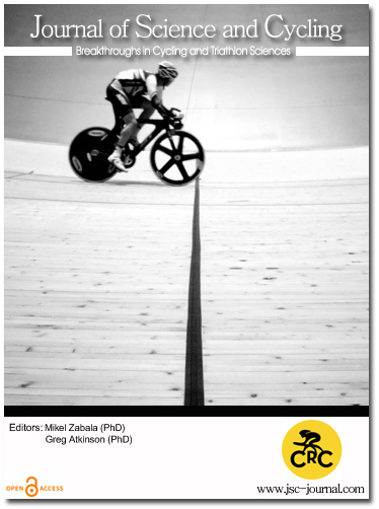Cyclo-cross Performance and Physiological/Psychological parameters
Abstract
Background: The new models of exercise performance consider both physiological and psychological parameters to better understand the performance (Marcora 2008: Eur J Appl Physiol 104: 929-931). Despite this, to our knowledge, no study tried to analyse jointly both physiological and psychological determinants of cycling performance. Several studies identified that peak power output and ventilatory/lactic thresholds were strong predictors of the performance in mountain bike and road cycling (Impellizzeri et al. 2005: J Sports Sci 23(1): 41-47; Hawley and Noakes 1992: Eur J Appl Physiol 65: 79-83). For psychological aspects, anxiety, self-confidence and a modified state of mind called Flow has been proposed as main determinants of the performance (Curry et al. 1999: Dossier EPS 43: 26-45; Jackson and Eklund 2002: J Sport Exerc Psy, 24, 133-150). Unfortunately, physiological and psychological determinants of cycling performance never were studied jointly. We used a French national cup of cyclo-cross to analyse some physiological and psychological parameters in young cyclists.
Purpose: To study the relationship between cyclo-cross performance and physiological/psychological parameters.
Methods: 12 cyclo-cross competitors (6 U19 and 6 U23) took part in this study. Their performances (final ranking of the race) were recorded during the first round of the French national cyclo-cross cup. During the following week, they performed constant duration tests in order to determine their maximal mean power output for duration of 1s (P1s), 5s (P5s), 30s (P30s), 4min (P4min) and 20min (P20min). They also answered two psychometric questionnaires (Flow State Scale-2, Jackson and Eklund 2002; and “Echelle d’état d’anxiété competitive”, Curry et al. 1999) in order to determine their levels of Flow, self-confidence, cognitive and somatic anxiety during the competition.
Results: Significant relationships were found between final ranking and P4min (r = -0.94; p < 0.05) and P20min (r = - 0.89; p < 0.05) for the U23 group (figure 1). No significant relationship was found between the performance and P1s, P5s, P30s and levels of Flow, self-confidence, somatic, cognitive anxiety. The level of Flow was homogeneous and relatively high in all the subjects (3.4 ± 0.5 on a scale of 1 to 5).
Discussion: The results of this study show that the U23 cyclo-cross performance could be related to P4min and P20min but not to psychometric questionnaires scores. In accordance with Pinot and Grappe (2011: Int J Sports Med 32: 839-844), these results suggest that the ability to produce high power output at both maximal aerobic power and anaerobic threshold is an important determinant of cyclo-cross performance. However, the lack of relationship between the performance and the psychometric scores shouldn’t be used to minimize the impact of psychological parameters in establishing a performance. It would be relevant and valuable to develop new methods and research tools to assess and analyse the relationship between cycling performance and psychological parameters.
Conclusion: The performance in cyclo-cross would partly depend to the ability to produce high level of power output at intensities close to both maximal aerobic power and anaerobic threshold (P4min and P20min). More accurate and sensitive questionnaires or research tools will be needed to better understand the psychological dimension of cyclo- cross performance.
Downloads
Published
How to Cite
Issue
Section
Copyright (c) 2015 Journal of Science and Cycling

This work is licensed under a Creative Commons Attribution-NonCommercial 4.0 International License.
Authors contributing to Journal of Science and Cycling agree to publish their articles under a Creative Commons CC BY-NC-ND license, allowing third parties to copy and redistribute the material in any medium or format, and to remix, transform, and build upon the material, for any purpose, even commercially, under the condition that appropriate credit is given, that a link to the license is provided, and that you indicate if changes were made. You may do so in any reasonable manner, but not in any way that suggests the licensor endorses you or your use.
Authors retain copyright of their work, with first publication rights granted to Cycling Research Center.






